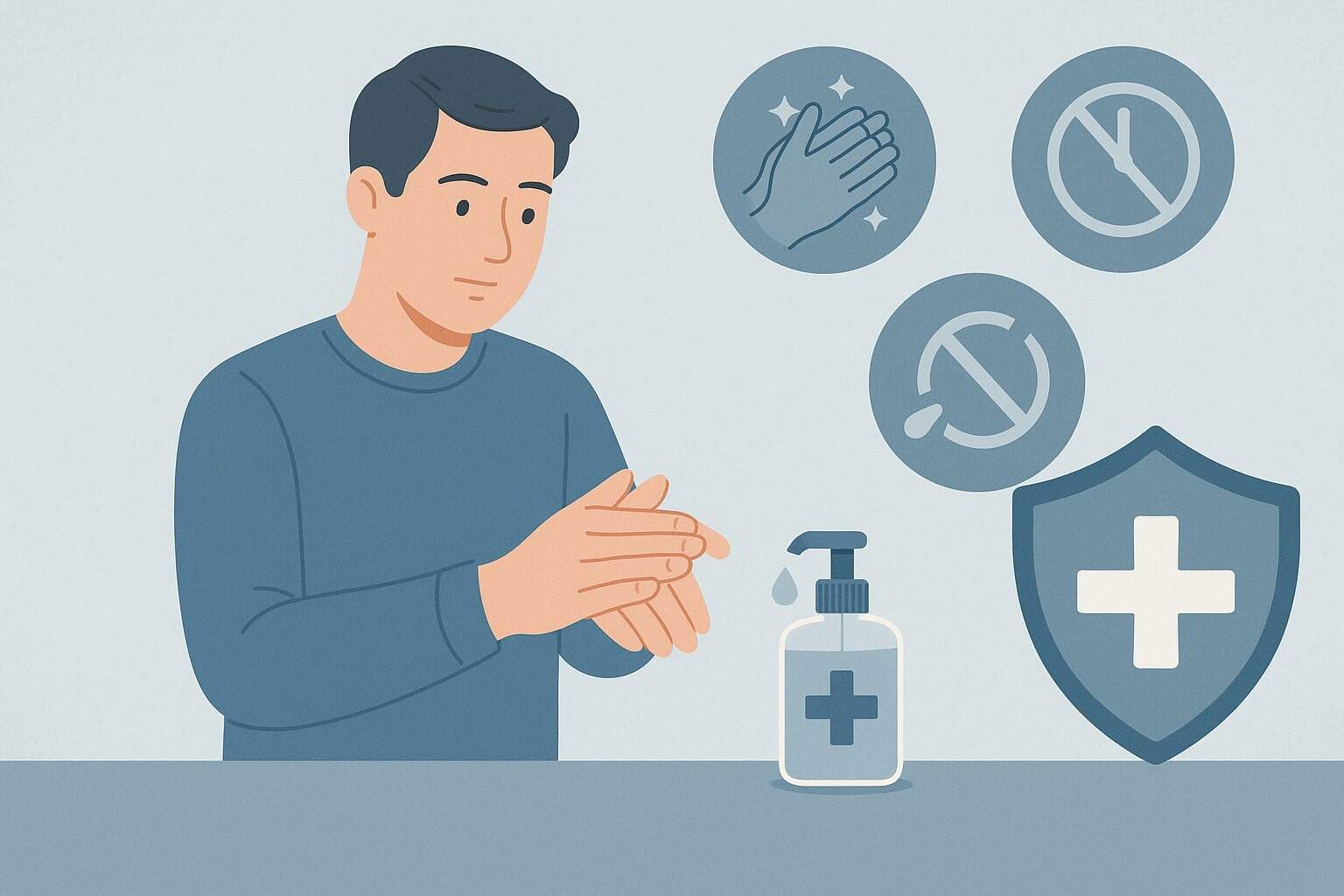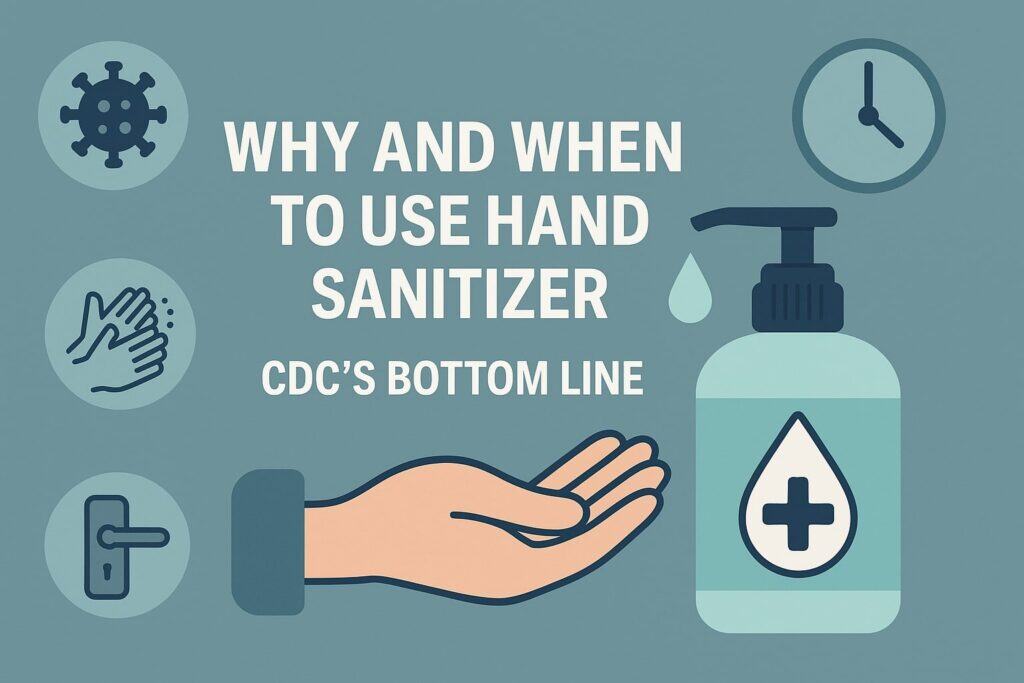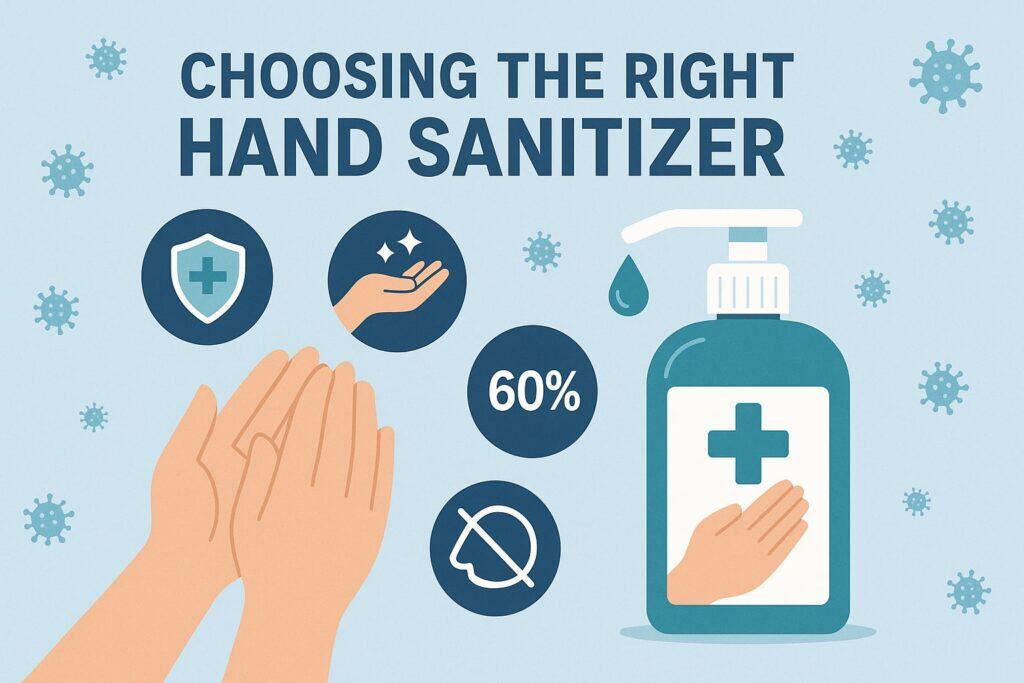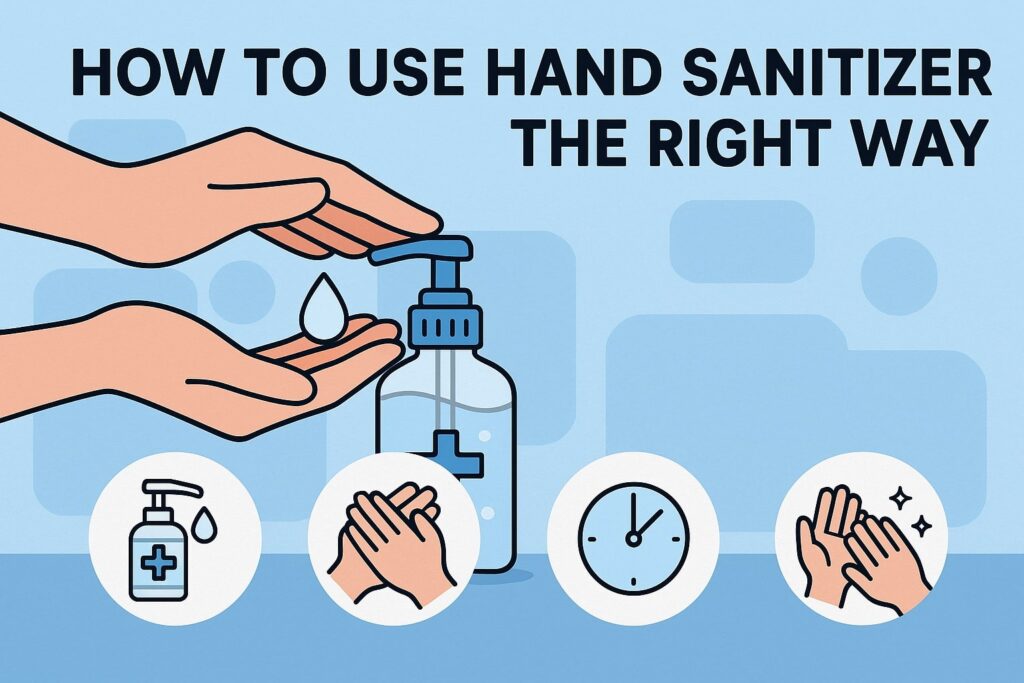
By myhandsanitizershop September 30, 2025
Hand sanitizer is one of the simplest tools you can carry to cut down the spread of many infectious germs when you’re on the go. But to get the benefit the Centers for Disease Control and Prevention (CDC) intends, you have to use the right product, at the right times, in the right way.
This comprehensive guide distills current CDC guidance—what kind to buy, when to use it instead of soap and water, how much to apply, how long to rub, when it won’t work well, and how to keep your family safe. Throughout, you’ll see clear, actionable steps backed by CDC sources so you can trust and use this information immediately.
In short: reach for an alcohol-based sanitizer with at least 60% alcohol when you don’t have access to soap and running water, use enough to cover all hand surfaces, and rub until your hands are completely dry.
In specific situations—like when your hands are visibly dirty or you’re dealing with certain hard-to-kill germs—CDC says soap and water beats sanitizer.
Why and When to Use Hand Sanitizer—CDC’s Bottom Line

The CDC’s core message is simple: washing with soap and water is the best choice in most situations because it removes a broader range of microbes and even chemicals from your hands.
Use hand sanitizer when soap and water aren’t available, and make sure the product contains at least 60% alcohol (ethanol or isopropyl alcohol). You can confirm the alcohol percentage on the product label. This threshold matters because formulations under 60% may not reduce microbe counts effectively enough to lower your risk.
There are also important limitations to remember. Alcohol-based sanitizers do not remove certain germs as effectively as soap and water, notably norovirus, Cryptosporidium, and Clostridioides difficile—pathogens that can cause intense gastrointestinal illness and are more resistant to alcohol.
In addition, sanitizer does not reliably remove harmful chemicals (e.g., pesticides, heavy metals like lead) from hands; again, soap and water are preferred in those scenarios. If your hands are visibly dirty or greasy, sanitizer won’t work as well either; the dirt and oils shield germs from the alcohol, so wash with soap.
A few “use cases” help lock this in. Hand sanitizer shines when you’re out and about—after touching public surfaces, before eating on the go, after using public transit, or between handwashing opportunities.
In high-traffic settings (stores, airports, schools), sanitizer can reduce microbes quickly until you can wash thoroughly. But if you’re caring for someone with diarrhea, cleaning up after vomiting, changing diapers, or preparing food, default to soap and water as soon as possible, especially during norovirus season; sanitizer alone “does not work well” against norovirus.
Finally, timing matters. The key moments for hand hygiene (wash or sanitize) include before eating, after using the bathroom, after coughing/sneezing, after handling garbage, and after touching animals or their waste.
When soap and running water are unavailable at any of these moments, sanitizer is an appropriate interim step—provided it meets the 60% alcohol threshold.
Choosing the Right Hand Sanitizer (What the Label Must Say)

Start with the most important line on the label: “Alcohol … 60% or more.” CDC guidance consistently calls for alcohol-based products at this strength because efficacy drops off below that mark.
You’ll typically see ethyl alcohol (ethanol) or isopropyl alcohol (isopropanol) listed as the active ingredient. Either can work, and many reputable brands use 62–70% ethanol. If the label lists no alcohol (for example, products relying only on benzalkonium chloride), that product does not meet CDC’s primary recommendation for community use.
Consider the format. Gels, foams, and sprays can all be effective if they contain the right alcohol percentage and you use a sufficient volume to fully wet both hands and rub until dry.
Fragrances and skin conditioners (like glycerin or aloe) can improve feel and reduce skin dryness, but they don’t replace alcohol; base your choice on comfort so you’re more likely to use it consistently.
If a product feels sticky or evaporates too fast to cover your hands, you may naturally use too little—switch to a brand whose texture lets you spread it thoroughly.
Packaging affects consistency. Pocket bottles with controlled flip-tops make it easier to dispense the right amount. Very small “mists” or automatic dispensers can be convenient but sometimes deliver less than you need; research has shown variability in dispensed volumes from some systems, which can compromise coverage if you don’t add more.
As a rule of thumb: if your hands aren’t wet all over, add another pump and continue rubbing. (This inference aligns with CDC’s emphasis on using enough volume to cover all surfaces before rubbing to dryness.)
Think about where you’ll store it. Alcohol evaporates; tightly close caps after use, and avoid leaving sanitizer in hot cars for prolonged periods since heat can hasten evaporation and reduce concentration over time.
While CDC doesn’t publish specific “expiry behaviors” for every brand, its usage directions imply that preserving alcohol content is critical to effectiveness. Rotate small bottles, and if a product loses its alcohol scent or seems unusually thin/thick, replace it.
Above all, keep sanitizer out of reach of young children and use it with adult supervision—ingestion risks are real (see “Safety” below).
How to Use Hand Sanitizer the Right Way (Step-by-Step Technique)

The CDC method is straightforward and precise. Apply the recommended amount to the palm—check the label for dosage, but practically, use enough to cover all surfaces of your hands.
Next, rub your hands together, covering fronts and backs, between fingers, thumbs, fingertips/nails, and around the wrists, until your hands are completely dry. Don’t wave your hands in the air or wipe them on clothing; dry by rubbing.
The process should take about 20 seconds when you’ve used enough product. The “until dry” instruction isn’t a throwaway line: alcohol needs contact time on skin to inactivate microbes; stopping early or using too little reduces effectiveness.
Coverage is the most common mistake. People often miss thumbs, fingertips (especially under the nails), and the backs of hands. A simple mental checklist helps: Front—Back—Between—Thumbs—Tips.
Start by rubbing palms, lace fingers to scrub between them, rotate each thumb in the opposite palm, drag fingertips across the palm to target nail beds, flip to the backs of hands, then circle each wrist.
Keep rubbing until all surfaces feel dry; if any area still feels wet or tacky, keep going. If drying takes only a few seconds, you likely didn’t use enough—add more next time.
What about gloves or visibly soiled hands? Don’t apply sanitizer on top of heavy dirt, grease, or lotions that form a barrier; wash with soap and water instead.
If you’re wearing gloves and touch a potentially contaminated surface, sanitize after you remove the gloves and perform hand hygiene; sanitizer on gloves is not a substitute for hand decontamination.
If you’ve handled chemicals, paint, pesticides, or metals (e.g., after a home project), sanitizer won’t remove those substances—wash thoroughly with soap.
Finally, remember the sequence. If hands are visibly clean and you’re stepping away from a public surface (say, after tapping a transit handrail) and can’t wash, sanitize immediately.
Before eating on the go, sanitize and try to avoid directly touching food with hands that have just touched packaging or surfaces. When you get to a sink, wash properly with soap and water to finish the job. This “sanitize-until-you-can-wash” approach is exactly how CDC envisions community use.
Technique Deep-Dive: Getting Full Coverage Without Wasting Product
People routinely under-dose sanitizer. The right amount is the quantity that leaves your hands noticeably wet for long enough to rub every surface until dry—typically around 20 seconds with a palmful for average-sized hands.
That time window matters because alcohol needs sustained contact to disrupt microbial membranes and proteins. If your sanitizer feels like it flashes off in 5–10 seconds, you probably didn’t use enough; if it’s still wet after 30–40 seconds, you may have applied too much.
Remember, however, that air temperature, humidity, and product formulation influence drying time, so judge by coverage more than the clock.
Use a repeatable pattern to avoid missed spots. Start with palms to palms, then right palm over left dorsum and vice versa, interlace fingers front and back, then interlock fingers into a “scrub” motion, rotate each thumb in the opposite palm, drag fingertips and nails across the opposite palm, and finish with wrists.
Visualizing this choreography helps you use the same number of motions every time, which boosts consistency in real life—like stepping off a bus or leaving a store.
If you carry a small bottle, consider a larger squeeze before high-risk moments (e.g., after coughing or sneezing into hands) to ensure adequate volume for coverage.
If your skin gets dry or irritated, don’t reduce the alcohol percentage; instead, choose a product with more emollients or moisturize after your last use of the day.
The CDC notes that alcohol-based hand rubs are generally less irritating than frequent soap-and-water washing in healthcare settings, which is one reason they are widely used between patient encounters.
In daily life, alternating sanitizer with proper handwashing—and adding a gentle moisturizer at home—keeps skin barriers healthy, which paradoxically helps reduce infection risk by preventing skin breaks.
Common Mistakes to Avoid (and How to Fix Them)
- Using too little: If a single tiny squirt dries before you can rub the backs of your hands, add more. Coverage is non-negotiable: alcohol must contact every surface.
Fix: Dispense enough to wet hands fully and rub for ~20 seconds until dry. - Stopping too soon: Waving your hands or wiping them on clothing cuts contact time short.
Fix: Keep rubbing until your hands are completely dry; count slowly or hum a short tune as you rub. - Relying on sanitizer when you need soap: If hands are greasy/dirty or you’re dealing with certain pathogens—norovirus, C. difficile, Cryptosporidium—sanitizer alone is not sufficient.
Fix: Seek a sink; wash thoroughly with soap and water for at least 20 seconds. - Using the wrong product: Non-alcohol or low-alcohol products may not deliver CDC-level effectiveness.
Fix: Choose alcohol-based sanitizer with ≥60% alcohol (check the label). - Not supervising kids: Children may lick hands or ingest products; ingestion can be dangerous.
Fix: Keep sanitizer out of reach; supervise use and rub hands until completely dry.
Situations Where Soap and Water Is Better Than Sanitizer
CDC is explicit: soap and running water is your first choice because it removes a wider range of microbes and chemicals. Sanitizer reduces many germs quickly, but there are clear scenarios where you should choose the sink.
If your hands are visibly dirty or greasy—after gardening, handling food, changing a tire—alcohol won’t get through the grime effectively.
Likewise, if you’ve been exposed to pesticides, heavy metals, or other chemicals, sanitizer won’t remove them; you need soap and water to physically wash contaminants away.
Certain pathogens demand extra caution. With norovirus, which spreads easily and causes vomiting/diarrhea, CDC specifically says hand sanitizer alone does not work well.
During norovirus outbreaks in the community or your household, emphasize thorough handwashing before eating, after using the bathroom, after caring for someone who is ill, and after cleaning potentially contaminated surfaces or laundry.
Similarly, for Clostridioides difficile (C. diff) and Cryptosporidium, soap and water is preferred for removing spores/oocysts that resist alcohol.
Food handling is another key context. Before preparing or eating food, and especially after handling raw meats or eggs, wash with soap and water. If you only have sanitizer temporarily (e.g., at a picnic), use it—but wash with soap as soon as you can.
After using the toilet, always wash when a sink is available; sanitizer is a stopgap if you truly can’t reach soap and water. And after blowing your nose, coughing, or sneezing, sanitizer helps in transit, but plan to wash hands properly at your next opportunity. These priorities mirror CDC’s broader hand hygiene messaging for families and the public.
Finally, remember sequences and layers. Use sanitizer as a bridge when you’re away from a sink, but “close the loop” with a proper wash later—especially during times of heightened GI illness in your area. This layered approach blends convenience with CDC’s evidence-based hierarchy of effectiveness.
Using Hand Sanitizer Safely (Adults, Children, Schools, and On the Go)
Safety starts with storage and supervision. Keep hand sanitizer out of reach of young children; supervise use and help them rub until hands are dry to minimize accidental ingestion or eye exposure.
Pediatric organizations emphasize that even small amounts swallowed by little kids can cause alcohol poisoning, with symptoms like confusion, vomiting, or drowsiness; lock bottles in bags or cabinets and choose packaging with secure caps. If a child ingests sanitizer or gets it in their eyes, seek medical advice promptly.
Be mindful of flammability and environmental factors. Alcohol is flammable in liquid and vapor form; while the risk is low during typical use, avoid using sanitizer near open flames or while handling ignition sources until hands are fully dry.
Heat can also accelerate alcohol evaporation in bottles; keep containers closed tightly and avoid prolonged storage in hot cars.
Although CDC’s public pages focus on efficacy and technique rather than product shelf life, the underlying principle is clear: the alcohol concentration must remain at or above effective levels to work, which means minimizing unnecessary exposure to heat and air.
In schools and childcare, combine sanitizer with education. Teach children the five steps of handwashing and the key times to wash (before eating, after bathroom, after recess).
Use sanitizer stations for transitions when sinks aren’t available, but reinforce that washing is best whenever possible. Post simple posters near stations: “Use enough to cover hands” and “Rub until dry.”
Encourage staff to carry pocket bottles during field trips and monitor younger students’ use. These classroom habits align with CDC’s family hand hygiene recommendations and help kids form lifelong routines.
For workplaces and travel, place dispensers at entry/exit points, high-touch areas, elevators, and near shared equipment. Consider carrying your own bottle to avoid under-dosing from small automatic dispensers; top up if your hands don’t feel fully wet at first.
After flights or transit rides, sanitize immediately, then wash at the earliest restroom opportunity. If you’re preparing or eating food on the move, sanitize first, try to avoid touching the eating surface, and plan for a soap-and-water wash later. These practical steps honor CDC’s “sanitize when you can’t wash” rule while keeping convenience in view.
Hand Hygiene in Community vs. Healthcare Settings (What Carries Over)
In healthcare, alcohol-based hand rubs (ABHR) are core to infection prevention between patient contacts because they reduce a broad array of microbes quickly and, compared with frequent soap-and-water washing, are associated with less skin irritation—which helps staff maintain high compliance.
The CDC highlights an important nuance: efficacy depends on the volume applied. Clinicians are trained to use enough product to keep hands wet long enough to rub all surfaces thoroughly, mirroring the community guidance but with stricter, audited technique.
During certain outbreaks (e.g., suspected or confirmed C. difficile or norovirus), facilities often emphasize soap and water because those organisms resist alcohol; this is another echo of CDC’s public guidance about limitations.
In the community, you don’t need clinical protocols—but the principles are the same: use an alcohol-based product with ≥60% alcohol, apply enough to cover all hand surfaces, and rub until dry.
Prioritize soap and water after restroom use, before food prep, and when hands are visibly dirty or after caring for someone with vomiting/diarrhea.
Families can turn this into a routine: sanitizer at the door after shopping or transit; handwashing when arriving home; sanitizer again after touching common surfaces outside.
These simple behaviors can significantly cut down on everyday respiratory and GI infections, particularly in seasons when norovirus is circulating widely.
A final consideration is communication. Whether you’re a manager, teacher, or parent, share the “why” behind your rules. People comply when they understand that alcohol percentage and contact time are non-negotiable, and that sanitizer isn’t magic—it’s a fast, convenient tool that must be used correctly and paired with soap and water at the next opportunity.
Posting brief reminders (≥60% alcohol; cover all surfaces; rub ~20 seconds until dry; wash when dirty or after bathroom; soap is best for norovirus) keeps everyone aligned with CDC’s science-based approach.
FAQs
Q.1: Is hand sanitizer as good as handwashing?
Answer: Short answer: No—handwashing is best in most situations. Soap and running water physically remove a wider range of germs and chemicals. Hand sanitizer (≥60% alcohol) is the next-best option when a sink isn’t available; it reduces many microbes quickly and is an excellent bridge until you can wash.
Use sanitizer properly—enough to cover all hand surfaces, rub until dry—and then wash with soap and water at your earliest opportunity, especially before eating or after bathroom use.
In practice, many people rely on sanitizer during commutes, shopping, or outdoor activities. That’s fine and helpful—but remember the limitations.
If your hands are greasy or visibly dirty, or you’ve been exposed to chemicals, sanitizer won’t work as well as soap and water. And for some pathogens like norovirus, sanitizer alone “does not work well,” so prioritize handwashing.
Q.2: What does “at least 60% alcohol” actually mean, and how do I check?
Answer: It means that the sanitizer’s active ingredient—ethyl alcohol or isopropyl alcohol—makes up 60% or more of the formulation by volume. Look at the “Drug Facts” label on the bottle; you should see “Active ingredient: Alcohol 62%” (for example).
Products below 60% may not reduce microbes sufficiently. If the label doesn’t list alcohol at all, it doesn’t meet CDC’s top recommendation for community use.
In daily life, you don’t need to split hairs between 62% vs. 70%—the bigger driver of effectiveness is using enough and rubbing until dry to ensure full coverage. Keep your bottle capped to minimize alcohol evaporation over time, and replace any product that seems to have lost its alcohol scent or spreads poorly.
Q.3: How much sanitizer should I use, and how long should I rub?
Answer: Use enough to make both hands visibly wet and to rub all surfaces—fronts, backs, between fingers, thumbs, fingertips/nails, and wrists—until your hands are completely dry.
That typically takes about 20 seconds when you’ve used a sufficient amount. If your hands dry faster than that, you probably used too little. Don’t wipe excess off on clothing; contact time matters.
If you use wall-mounted dispensers or tiny mists that provide a small squirt, use a second dose to achieve full coverage. Healthcare guidance underscores that efficacy depends on volume, a principle that transfers directly to community use.
Q.4: Does hand sanitizer work against norovirus?
Answer: CDC guidance is clear: hand sanitizer alone does not work well against norovirus. Alcohol-resistant features of this virus make soap and water the preferred choice, especially during outbreaks or when someone at home is ill with vomiting/diarrhea.
Focus on frequent, thorough handwashing; disinfect high-touch surfaces; and avoid preparing food for others while sick. Use sanitizer if no sink is available, but wash with soap and water as soon as possible.
This isn’t to say sanitizer is useless during norovirus season—it can still reduce some microbes on otherwise clean hands and is helpful between washes—but it should never replace proper handwashing for prevention in this context.
Q.5: Is hand sanitizer safe for children?
Answer: Used correctly and with adult supervision, hand sanitizer is safe and useful for children, especially when sinks aren’t available. Apply a small amount to their hands, help them rub all surfaces, and make sure hands are fully dry before they touch their face or eat. Store bottles out of reach, and choose packaging with secure caps.
The key risk for kids is ingestion. Even small amounts can be dangerous if swallowed because of the alcohol content. If you think a child has ingested sanitizer or gotten it in their eyes, seek medical guidance right away.
The supervision message mirrors CDC’s family-focused hygiene advice: teach kids when to wash, when to sanitize, and how to rub until dry.
Q.6: What about using sanitizer before eating or while cooking?
Answer: Before eating, washing with soap and water is ideal; use sanitizer only if you lack access to a sink, then wash as soon as you can. For food preparation, particularly after handling raw meat or eggs, soap and water is the standard.
Sanitizer can be a temporary measure during outdoor meals or travel, but it doesn’t remove oils and food residues well, and it won’t remove chemicals or certain hardy germs.
If you must handle food after sanitizing, make sure your hands are fully dry; lingering alcohol can transfer odors or taste. But treat this as a stopgap—plan to wash with soap and running water at your earliest opportunity.
Conclusion
The CDC’s guidance can be boiled down to a memorable hierarchy: Soap and water first; sanitizer when you can’t wash; and technique is everything. In real-world terms, that means carrying an alcohol-based sanitizer (≥60% alcohol), using a generous amount to cover all hand surfaces, and rubbing until completely dry.
It also means recognizing when sanitizer isn’t the right tool—visibly dirty or greasy hands, chemical exposures, and alcohol-resistant pathogens like norovirus—and seeking out a sink in those scenarios.
Parents should supervise children, keep bottles out of reach, and incorporate hand hygiene into family routines so kids learn when and how to clean their hands effectively.
Make these steps automatic and you’ll use sanitizer the way CDC intends: as a fast, convenient, science-backed bridge to proper handwashing, not a replacement for it.
That small shift in daily habits—dispensing enough product, rubbing until dry, and choosing soap and water when it matters most—can quietly but significantly lower your risk of getting sick and spreading germs to others.